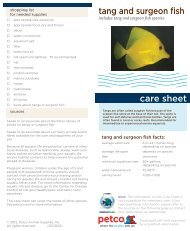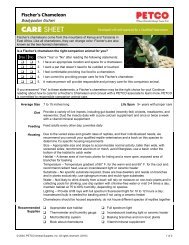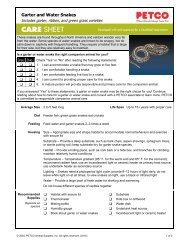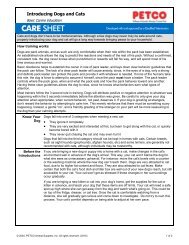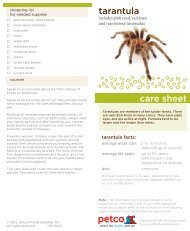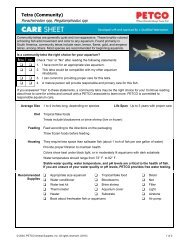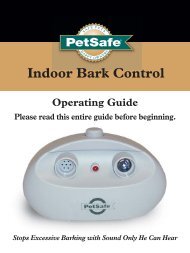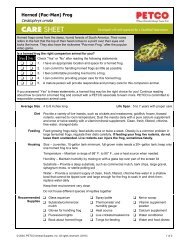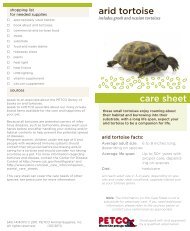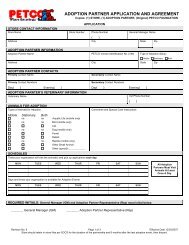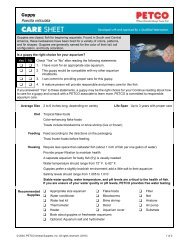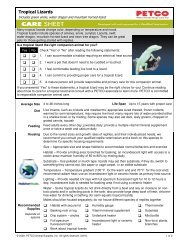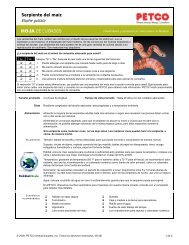Kennel Training - Petco
Kennel Training - Petco
Kennel Training - Petco
Create successful ePaper yourself
Turn your PDF publications into a flip-book with our unique Google optimized e-Paper software.
Tips for <strong>Kennel</strong><strong>Training</strong> Your Dog• During the first few days of training, placethe kennel in your bedroom at night to helpyour pet adjust to his new environment and toalleviate stress.• Stuff hollow white sterilized bones withpeanut butter, cheese or a little meat.Two of these healthy treats a day will keepyour pup occupied for hours!• Rotate out three or four new toys every threeweeks or so — a new smell and feel will keephim interested in chewing on appropriateobjects.• Take your pet to his potty area beforeplacing him in his portable kennel for travel.• Never leave your pet unattended in a car.If your dog must ride in the backof a pickup truck, be sure thekennel is safely secured so it doesn’tslide around.• Never allowchildren totease your petwhile he is inthe kennel.How to <strong>Kennel</strong> Train?• Do not leave your young pup in his portablekennel all day; like babies, puppies have to“potty” about every 2-4 hours, most likely rightafter waking, eating, drinking and playing.At best, a puppy can “hold it” about1 hour longer than his age in months.For example, if your puppy is 3 months old, donot leave him in his kennel for more than4 hours at any given time. Take him outsideregularly and praise him when he eliminates;soon you’ll be able to leave the kennel dooropen all the time.• If your dog has an accident in his portablekennel, it is probably too large or you left himin the kennel too long.• NEVER punish your dog by forcing him in hisportable kennel or reprimanding him while heis in it. This is his ”special” place and it shouldalways represent a safe and happy place.• Always keep fresh water in his kennel to keepyour dog hydrated.• Always keep at least 2 of your dog’s favoritechew toys in his portable kennel. Chew toyskeep him interested in chewing on appropriateobjects and discourage a pup’s incessantbarking by keeping him occupied.• Be careful not to ruin the effectiveness of theportable kennel by putting your pup in it whenhe needs to potty. Always take him outsideBEFORE placing him in the portable kennel.• A portable kennel + 2 or 3 chew toys + dogtreats + lots of praise = a better-adjustedand self-confident pet.<strong>Kennel</strong><strong>Training</strong>For more information,check out our website at:www.petco.comHousebreaking &Behavior Solutions Tool
Why <strong>Kennel</strong> Train?• Dogs have a natural tendency to “curl up”in small areas. You can simulate your pet’s“denning” instinct in your own home using aportable kennel. A portable kennel providessecurity and comfort at home or during traveland helps control behavioral problems.• By providing a portable kennel for your dog,you are essentially providing him his own“special” place where he can always relax andfeel safe and secure.• A portable kennel is the quickest and easiestway to “housebreak” your dog.Because dogs will not “go” in thearea where they eat and sleep, youcan train him to “potty” outside.• Dogs can get injured while traveling aspassengers in vehicles, therefore aportable kennel is essential for transportingyour pet safely in a car or plane.• Portablekennels aretransportableand can bemoved from thehome to a car,plane, or hotelas easy as1-2-3! Your dogcan have hisown “special”place whereverhe goes!When to <strong>Kennel</strong> Train?• Your puppy’s training should begin between7 and 16 weeks of age. Studies show that themost critical learning period occurs at this time.• As soon as your new pup arrives, introducehim to his portable kennel gently and cheerfully.Place a chew toy or little treat inside toencourage him to go in on his own.Never force your puppy insidethe kennel. Be patient and he’lleventually go in on his own.When he does, reward him with lots of praise!It’s important that your pet associate his “new”home with feelings of safety and security fromthe very beginning.• Potty training begins at 8-10 weeks of age andusually takes about 4 weeks to completely trainhim to “potty” outside.• Simply decide how you want your pup tobehave as an adult dog and teach him to behave that way now. Although it is much easierto train a puppy, you can also kennel train anadult dog. Obedience, when taught withkindness and affection, frequentlyincreases any pet’s confidence.Once this is established,you are on your way tobuilding a long-lasting& rewarding relationshipwith your pet, no matterhow young or old.How to <strong>Kennel</strong> Train?• Separate food and water dishes arerecommended.• Choosing the proper kennel size isvery important.Your pet should have just enoughroom to stand up, turn aroundand curl up.• Place an old towel or blanket with your scenton it inside for bedding. Do not use a dogpad or bed until your puppy has outgrownaccidents and chewing.• Select a permanent location in your homethat provides enough space for the kenneland is in a room full of activity. Your pet willwant to enjoy his own “special” place whilestill being part of the family.• Begin by keeping the door open andallowing your puppy to get comfortablewith going in and out on his own. Next,make him stay in it for a few minutes byrestraining him at the door with your hand.Remember to praise him and reward himwith a treat! Gradually increase the time.Once he is comfortable with being insidethe kennel at this point, you will want torestrain him at the door with the door.Stay in sight and always praise your pet andreward him with a treat for good behavior!• Do not leave your dog unattended in hiskennel with his collar on.• This training session may take afew hours or days depending onthe differences in temperament.Once he feels secure in thekennel with the doorclosed, the pup willeventually sit quietlyand sleep in his“new” home.



